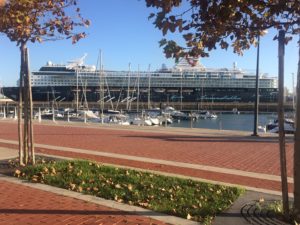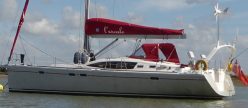Sunday 3 – Monday 4 November
At this time of year, it is important for us, when planning a passage of more Miles than can be sailed in daylight, to try to ensure that we arrive while it is light. When everything is going to be new and unfamiliar, our least favourite landfalls are during the night, when important navigation lights can be buried amongst lights from land, and hazards and the ‘hard stuff’ are much less visible. Having said that, night passages – being out at sea in the dark – are often a wonderful experience. Whatever phase of the moon, in clear skies its rise and set, and the canopy of stars slowly revolving across the heavens, never fail to delight.
And so it was that we set off from the Southern coast of Portugal at tea time, bound for another border and another country. As usual, we kept ourselves busy with various combinations of sails, starting with just the genoa, and around dusk changing to full main and staysail in a steady Westerly breeze of F4-5 on a slight sea. Around midnight, the moon set and the sky became cloudy, making it very dark, but this is when phosphorescence is most visible: tiny plankton, disturbed by our hull sliding through the water, glow momentarily in a constant sparkle trailing behind our stern – ethereal and beautiful.
In the early hours of the morning, we were called by American warship William McLean, asking us to change course to keep our distance from their patrol course – a little unnecessary, we felt, as we were sailing, less manoeuvrable than their powerful motor vessel, and had to perform a gybe to meet their ‘request’. We had to gybe several more times to regain our proper course. Once daylight was properly established, we changed up from staysail back to genoa, gaining 0.5 knot speed. As we crossed the notional border line into Spain, we changed the courtesy flag.
We maintained ship’s time during the passage, in spite of actually losing an hour as we left Portuguese waters, and mid-morning, Mate had to make an unwelcome decision to steer to port to avoid an unscheduled close acquaintance with another yacht. ColRegs (the rules of the sea to which every vessel must adhere to avoid collisions) clearly state that vessels on a potential collision course must both turn to starboard. A red-hulled Russian-flagged yacht was approaching our port bow on a starboard reach (wind from the right, onto the middle of the boat), and we were also on a starboard tack, with the wind further behind us. Technically correctly, he held his course as we were the ‘windward’ boat (nearer the wind), but he forced us into a near gybe, as we moved further away from the wind by having to turn to port, and added insult to injury by tacking to starboard immediately he cleared our bow – and giving a cheery wave as he did so. Grrrrr.

Nevertheless, we arrived safely in Porto America in Cádiz, Andalucia, in time for a late lunch, having sailed 96 Miles in a little less than 21 hours. [When afore-mentioned red Russian yacht later berthed a few slots from us, an unusual lack of welcome was expressed from l’escale].
